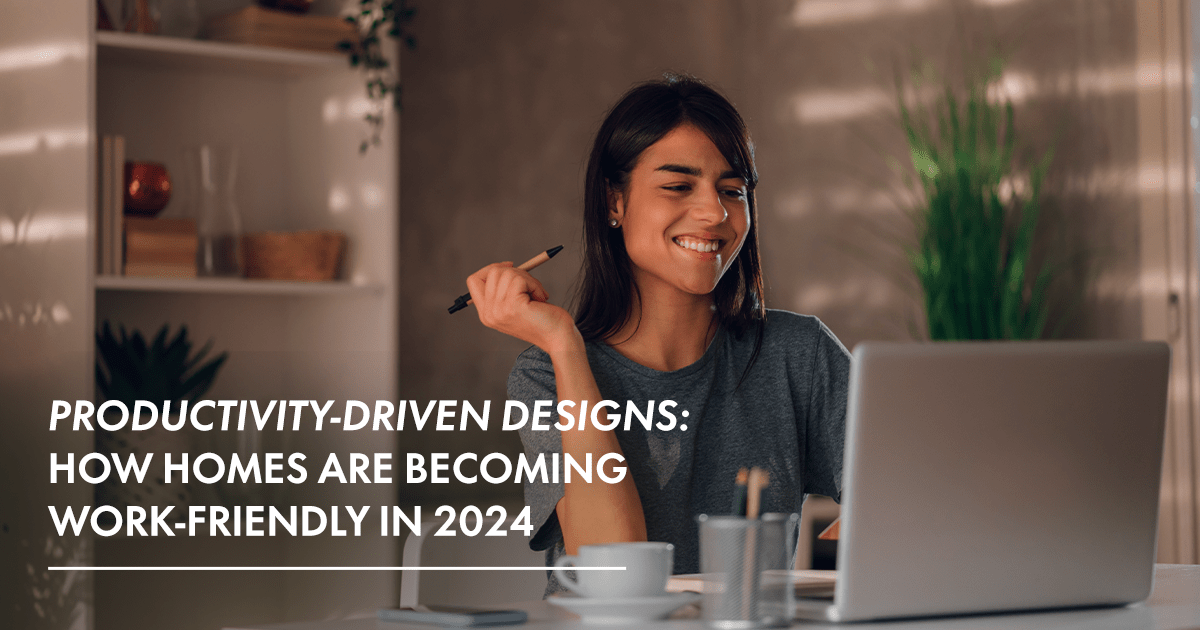
Enquire Now
Productivity-Driven Designs: How Homes are Becoming Work-Friendly in 2024
In 2024, as more companies embrace the work-from-home culture, the concept of a traditional office is undergoing a significant transformation. The shift to remote work has necessitated a reevaluation of home spaces, giving rise to productivity-driven designs that seamlessly integrate work and living areas. It’s not just about a place to live anymore; it’s about creating a work-friendly environment within the confines of one’s home.
As the work-from-home trend gains momentum, individuals find themselves spending a considerable amount of time within their homes, juggling professional responsibilities with daily life. Companies across various industries are adopting flexible work arrangements, allowing employees to work from the comfort of their homes. Recognizing this shift, architects and designers are now focusing on creating homes that not only cater to the basic needs of shelter but also serve as functional workspaces. Here are some changes that architects and designers are embracing to make your home perfect to juggle between your work and everyday life.
- Dedicated Workspaces
Architects are incorporating dedicated workspaces within residential designs. These spaces are designed to be practical and conducive to focused work, ensuring that individuals can maintain a clear boundary between their professional and personal lives. The days of makeshift home offices at dining tables are giving way to purposeful, integrated work areas.
- Natural Light
Natural light has emerged as a key element in these productivity-driven designs. Large windows and open spaces are strategically designed to allow ample natural light to flood the interiors. This not only reduces the reliance on artificial lighting but also contributes to a brighter, more invigorating atmosphere that promotes concentration and overall well-being.
- Ergonomics
Ergonomics, too, plays a crucial role in the evolution of home designs. With the understanding that individuals spend extended hours working from home, designers are integrating ergonomic furniture into these spaces. Adjustable standing desks, comfortable chairs, and other ergonomic elements are seamlessly blended into the overall design, prioritizing both comfort and functionality.
- Smart Solutions
The rise of smart home technology is another notable aspect of productivity-driven designs. Home automation systems allow individuals to control various aspects of their living spaces through smartphones or other devices. From adjusting lighting to temperature, this technology not only enhances convenience but also contributes to a more streamlined and efficient work environment.
- Private Space
As work and home life converge, the need for privacy within the home has become increasingly apparent. Productivity-driven designs address this by incorporating soundproofing materials and innovative room dividers. These features ensure that individuals can create a dedicated and private workspace, even in the midst of a bustling household.
A noteworthy example of a project embracing productivity-driven designs is the Phoenix Kessaku project in Bangalore. This residential development embraces the changing dynamics of home design, where luxury living seamlessly integrates with work-friendly spaces. The architects have thoughtfully crafted homes that allow residents to switch between work and leisure effortlessly.
Phoenix Kessaku offers the scenic views of Bangalore by incorporating large windows and open spaces. The inclusion of green spaces and terrace gardens not only enhances the aesthetic appeal but also contributes to a healthier and more refreshing work environment. The integration of smart home technology adds an extra layer of sophistication, allowing residents to personalize their living spaces to suit their work preferences.
The evolution of productivity-driven designs in homes reflects the changing nature of work in 2024. Homes are no longer just places to live; they are now integral to the way individuals work and live simultaneously.


